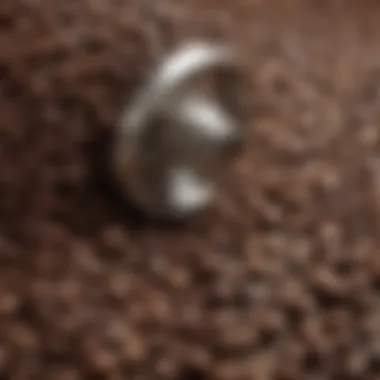Best Large Coffee Grinder: A Comprehensive Exploration


Intro
In the world of coffee, the quality of the brew often hinges on one critical component: grind size. This fundamental aspect can significantly impact the flavors and aromas released during brewing. Large coffee grinders have gained popularity among home baristas and enthusiasts. Their ability to handle larger quantities makes them ideal for brewing multiple cups or for those who simply relish the coffee-making process.
This article will provide a thorough exploration of the best large coffee grinders available today, accompanied by insights on their features and functionalities. Understanding the importance of grind size can enhance your coffee experience. Evaluating different types of grinders allows consumers to make informed choices tailored to their specific needs.
As we delve deeper, we will discuss the factors to consider when purchasing a large grinder, maintenance tips to prolong its life, and a detailed comparison of top-rated models. Let’s embark on this journey to elevate your coffee-making experience.
Prelims to Large Coffee Grinders
Large coffee grinders play a pivotal role in the world of coffee brewing. They aren’t just tools; they are the foundation for creating that perfect cup. Many enthusiasts know that the quality of their coffee largely depends on the grind size and uniformity. Hence, understanding large coffee grinders is essential for anyone serious about their coffee.
Defining Large Coffee Grinders
Large coffee grinders are designed to handle bigger batches of coffee beans. Unlike smaller grinders, which often limit the amount you can prepare at one time, large grinders allow you to grind several ounces at once. This is particularly beneficial for those who prepare coffee in larger quantities, such as families or small offices. Their design often includes a robust build, allowing them to grind beans more efficiently and consistently.
A few characteristics distinguish large coffee grinders. Most of these grinders offer different grind settings, which enables users to customize their coffee according to their preference. The capacity also tends to be greater, often ranging from 10 to 40 ounces or more, depending on the model. Furthermore, the technology used in larger grinders often includes burr grinding mechanisms, known for producing a more uniform grind compared to blades.
Significance in Coffee Preparation
The significance of large coffee grinders in coffee preparation is multifaceted. First, consistency in grind size directly influences the flavor profile of the coffee. A precise and uniform grind results in an even extraction of flavors during brewing, leading to a balanced cup. In contrast, a variable grind size could yield a bitter or weak taste, ruining the overall experience.
Additionally, large grinders can significantly enhance efficiency. For those who enjoy hosting gatherings or brewing multiple cups for family, a large grinder means less time spent grinding and more time savoring the coffee. The ability to prepare larger quantities also makes these grinders ideal for those who may want to experiment with different beans or roast types without the hassle of using multiple loads.
Types of Coffee Grinders
Understanding the different types of coffee grinders is crucial for selecting the right one that meets both personal taste and functional requirements. Each type of grinder has unique characteristics that influence grind uniformity, flavor extraction, and ultimately, the coffee experience. When discussing large coffee grinders, the distinction between blade and burr grinders becomes particularly pertinent, as they deliver vastly different results in the coffee preparation process.
Blade Grinders
Blade grinders are among the most common and affordable options available. They work by using sharp blades, which rotate at high speeds to chop coffee beans into varying sizes. While they are relatively easy to use, they often produce inconsistent grind sizes. This inconsistency can affect the quality of the brewed coffee significantly.
One of the primary benefits of blade grinders is their accessibility; they are inexpensive and lightweight. However, they lack the precision that coffee enthusiasts often desire. The heat generated by the blades can also affect the coffee's flavor, making them less favorable for those who prioritize quality.
Burr Grinders
Burr grinders represent a more sophisticated option, utilizing two revolving surfaces to crush beans evenly. This method ensures a consistent grind size, which is essential for optimal extraction during brewing. When exploring burr grinders, two main types emerge: flat burr grinders and conical burr grinders.
Flat Burr Grinders
Flat burr grinders utilize a set of parallel burred plates to achieve their grind. This design allows for uniform coffee particle sizes, which is significant for brewing methods requiring precision. One of the key characteristics of flat burr grinders is their ability to produce a very fine and uniform grind, making them a popular choice among baristas and serious coffee drinkers.
The unique feature of flat burr grinders lies in their adjustable settings, allowing users to experiment with grind sizes suitable for different brewing methods. However, some users may find that they are slightly noisier and more expensive compared to blade grinders.
Conical Burr Grinders
Conical burr grinders are designed with a cone-shaped burr that fits inside a ring burr. This design contributes to a slower grinding process, which reduces heat buildup, a factor that can adversely impact flavor. The ability to grind beans at a lower temperature is a major advantage of conical burr grinders, enhancing the overall quality of the coffee.


Their key characteristic is the ability to handle a variety of grind sizes effortlessly. This versatility allows users to switch between brewing methods with relative ease, from espresso to French press.
However, even though conical burr grinders are generally more favored, they can sometimes be more expensive, and some models may not be as easy to clean as others.
Manual vs. Electric Grinders
Choosing between manual and electric grinders entails consideration of user preferences and requirements in terms of convenience and control. Manual grinders require some physical effort and can be less convenient, yet they often allow for greater control over the grind size. Electric grinders, while more straightforward and time-efficient, may lack the hands-on experience many coffee aficionados cherish. Both types have their own merits and drawbacks, appealing to different segments of coffee enthusiasts.
Choosing the Right Grind Size
Selecting the appropriate grind size for coffee is critical. It influences brewing methods and the final taste in the cup. Different coffee makers require various grind sizes. Understanding this concept enhances the coffee experience significantly.
Understanding Grind Size and Its Impact
Grind size affects extraction, the process where water interacts with coffee to draw out flavor. A grind that is too coarse may result in under-extraction, leading to a weak taste. Conversely, a fine grind can cause over-extraction, producing bitterness. Therefore, the right grind size is essential for achieving a balanced and flavorful brew.
For instance, when using a French press, a coarse grind is preferred to allow for full immersion without clogging the filter. In contrast, an espresso machine requires a fine grind for quick extraction under pressure.
Common Grind Size Specifications
Understanding the different grind sizes and their characteristics helps in tailoring the coffee experience. Below are the common specifications:
Coarse Grind
A coarse grind consists of large particles. This grind size is commonly used for brewing methods that require long steep times, such as the French press. The key characteristic of coarse grind is its ability to prevent over-extraction. It's beneficial for brewing since it allows for proper extraction while avoiding bitterness. However, it may lack intensity if the steeping time is not adjusted correctly, making it crucial to find the right balance.
Medium Grind
A medium grind has a texture somewhat similar to granulated sugar. It becomes a versatile choice for many brewing methods, including drip coffee makers and pour-over systems. The utility of medium grind lies in its balance; it facilitates a good extraction without overwhelming overly bitter flavors. The unique feature of this grind is its adaptability. Still, it may not be ideal for very fast or very slow brewing methods.
Fine Grind
A fine grind offers the smallest particle size. It is essential for espresso and Aeropress brewing methods. The main advantage of fine grind is its increased surface area, which aids rapid extraction under pressure. It’s popular for creating intense and rich coffee flavors. However, fine grind can easily lead to over-extraction if brewing time is not carefully managed. Therefore, using it requires attention to detail in the brewing process.
Choosing the right grind size not only affects taste but also enhances the overall coffee experience. Ensuring that you pick the appropriate size for your method will ensure a perfectly brewed cup.
Key Features to Evaluate
When considering the purchase of a large coffee grinder, certain key features are paramount. These features not only influence the performance but also the overall user experience. Understanding these elements is critical for making an informed choice.
Capacity and Size
Capacity is a fundamental factor in selecting a large coffee grinder. It refers to the volume of coffee beans the grinder can hold at one time. For those who regularly brew coffee in significant quantities, such as home baristas or anyone hosting gatherings, a larger capacity is essential.
A grinder with a substantial size can accommodate more beans, allowing users to grind coffee for multiple servings without frequent refills. Conversely, a device with smaller capacity may lead to inconvenience, especially during busy mornings or events.
Moreover, the physical size of the grinder also matters, particularly for those with limited countertop space. It's important to balance the grinder's capacity with its footprint in the kitchen. Brands like Baratza and Breville often produce models that maximize capacity without occupying excessive space, making them suitable for various kitchen layouts.


Grind Settings and Versatility
The ability to customize grind settings plays a significant role in the versatility of a large coffee grinder. Different brewing methods require specific grind sizes. For example, a French press typically needs a coarser grind while espresso requires a fine grind. Therefore, a grinder with adjustable settings allows users to experiment and find their preferred coarseness or fineness.
Many high-quality grinders, such as the Rancilio Rocky, offer numerous grind settings. This flexibility can enhance your coffee experience by ensuring that every cup is brewed to perfection. Additionally, a versatile grinder may also cater to the needs of various brewing equipment, be it pour-over, drip, or a cold brew.
Ease of Cleaning and Maintenance
Maintenance is often overlooked when selecting a large coffee grinder. However, it plays a crucial role in the longevity of the product. Regular cleaning prevents residual oils and coffee grounds from altering the flavor of future batches.
Look for grinders that are designed for easy disassembly, allowing for quick and thorough cleaning. Some models offer features like removable grinding chambers, which simplify the cleaning process. It's advisable to choose grinders made from materials that resist staining and are easier to wipe down, such as stainless steel.
Regular maintenance not only extends the life of your grinder but also plays a significant role in the quality of the coffee produced.
Top Large Coffee Grinders on the Market
When it comes to large coffee grinders, their significance in the coffee preparation process cannot be overstated. These grinders play a vital role in enhancing flavor extraction by providing a consistent grind size. A uniform grind ensures that water passes through the coffee grounds evenly, leading to a more balanced and rich flavor profile in the cup. In addition, the capacity of large grinders makes them suitable for those who brew coffee in bulk, whether for gatherings, parties, or even for deeper coffee enthusiasts looking for efficiency without sacrificing quality.
Product Reviews: Overview
Review Criteria
The review criteria for large coffee grinders focus on several key aspects that contribute to overall performance. These include grind uniformity, ease of use, capacity, and durability. For instance, a grinder that offers consistent particle sizes will certainly maximize flavor and aroma. On the practical side, ease of use accounts for intuitive controls and design, allowing users to achieve their desired grind settings without hassle. Moreover, a robust build speaks to the longevity of the grinder, making it a worthwhile investment. These elements stand out as beneficial for anyone choosing a reliable grinder.
Comparison Metrics
Comparison metrics play an important role by enabling buyers to evaluate various models comprehensively. Key features for comparison could include grind speed, motor power, and noise levels. For example, a grinder with a powerful motor produces grounds faster, which may appeal to those who prioritize efficiency. However, it might create more noise, which is a consideration for some users. Thus, effective comparison metrics help in assessing both functionality and user satisfaction, ensuring that the right product is selected based on individual needs.
Popular Models Reviewed
Model A: Features and Performance
Model A provides a noteworthy example of performance-driven design. Its most significant feature is the precision burr grinding mechanism that ensures even particle distribution. This is central to achieving optimal extraction. Suitable for both espresso and French press, versatility is one of its most attractive characteristics. However, the more advanced features may lead to a steeper learning curve for new users, which could be seen as a disadvantage.
Model B: User Experience
In evaluating user experience, Model B stands out for its reliable functionality and user-friendly interface. Users praise its clear labeling and straightforward controls, making it easily operable for different grind sizes. However, some have noted that its capacity may not meet the needs of frequent bulk users, which could be a limitation in certain scenarios. Yet, for home users or casual coffee drinkers, it serves as a dependable machine.
Model C: Price Point Evaluation
Price point evaluation is crucial when deciding on a large coffee grinder. Model C excels in this regard by offering a solid balance between quality and affordability. The pricing makes it accessible for users who want durable equipment without overspending. One unique feature is the warranty period offered, which extends protection against defects, enhancing buyer confidence. However, some users report minor fluctuations in grind consistency, which could detract from its overall appeal.
"Investing in a high-quality grinder is essential for achieving the best flavor in your coffee."
Durability and Longevity
When selecting a large coffee grinder, durability and longevity are pivotal considerations. These factors influence not only the lifespan of the grinder but also its performance over time. A durable coffee grinder can consistently deliver high-quality grinds, contributing to a superior coffee experience. Additionally, understanding the aspects that contribute to a grinder's durability can prevent future frustrations and expenses associated with repairs or replacements.


Material Quality Insights
The materials used in constructing a coffee grinder play a critical role in its overall durability. Typical materials include stainless steel, plastic, and aluminum. Stainless steel is often the gold standard due to its resistance to wear and tear, as well as its ability to resist corrosion. Plastic components may be less expensive, but they can warp or crack with time, especially if subjected to heat or heavy usage. As such, investing in a grinder with high-quality materials can pay off in the long run.
When assessing material quality, consider the burrs or blades as well. Burr grinders usually feature harder materials, such as ceramic or hardened steel, that maintain sharpness longer than their blade counterparts. The longevity of these components is crucial for achieving consistent grind sizes and ultimately affects the flavor extraction of your coffee.
Manufacturer Reputation Considerations
A reputable manufacturer often signifies a commitment to quality and customer satisfaction. Brand reputation can be integral when choosing a large coffee grinder. Brands that have been in the market for significant periods typically have a track record of reliability and product performance.
Look for companies that offer warranties and post-purchase support. A long warranty period usually indicates the manufacturer’s confidence in the durability of their product. Customer reviews can also provide valuable insights regarding a brand's reliability. Analyzing feedback from users who have owned the product for an extended time can help gauge its true longevity and performance.
"A quality coffee grinder is not merely a tool; it's an investment in your coffee journey."
Maintenance Tips for Longevity
Maintaining a large coffee grinder is essential for ensuring endurance and optimal performance. Proper care not only extends the life of the grinder but also enhances the quality of the coffee it produces. Grinders often get overlooked, yet neglect can lead to residue buildup, power issues, and diminish the flavor of your brew. Given that coffee enthusiasts prioritize freshness and taste, regular maintenance becomes paramount.
Regular inspections and cleaning practices help in preventing unwanted disturbances such as uneven grind sizes. This review of effective maintenance tips will provide invaluable insights into how to keep your grinder functioning smoothly and efficiently.
Regular Cleaning Protocol
An effective cleaning protocol is key to preserving your grinder’s performance. Here are some steps to follow:
- Daily Wipe Down: After each use, wipe the exterior of the grinder with a damp cloth. This helps to avoid dust accumulation.
- Burr Inspection and Cleaning: If using a burr grinder, regularly remove the burrs and clean them. Coffee oils and fine coffee dust can build up, affecting flavor. Use a soft brush to clean.
- Deep Cleaning: Every month, perform a deep clean. Disconnect the grinder, remove all parts, and clean them thoroughly with a safe cleaning solution. Rinse well and let them dry completely before reassembling.
Keeping to this protocol ensures that the coffee grinder operates without hindrance, maintaining the grind consistency and flavor integrity of your coffee.
Avoiding Common Mistakes
Avoiding mistakes in grinder maintenance can significantly impact performance and longevity. Here are some pitfalls to avoid:
- Neglecting Periodic Cleaning: Letting buildup occur can lead to clogs or damage. Regular attention is essential.
- Using Harsh Chemicals: Avoid bleach or abrasive cleaners which can damage parts or leave residues. Opt for natural cleaners.
- Ignoring Grind Size Adjustments: If your grinder allows for adjusting grind sizes, make modifications based on your brewing method. Not doing so can lead to poor extraction and a subpar cup.
- Overloading the Grinder: Putting too many beans at once can strain the grinder's motor. Stick to recommended amounts for best results.
By addressing these concerns, coffee lovers can ensure their large coffee grinders operate at peak performance for years to come. Proper maintenance requires little effort but provides rewarding outcomes in flavor and durability.
Epilogue
In this article, the emphasis has been on understanding the complexities and advantages of choosing the right large coffee grinder. Coffee enthusiasts need to consider several aspects before making a purchase. From grind size to durability, each factor plays a crucial role in ensuring the best coffee experience.
The final insights shared in this guide are instrumental in helping buyers make informed decisions. Investing in a quality large coffee grinder is not just about convenience; it enhances the overall flavor and aroma of the coffee. A properly chosen grinder can preserve the integrity of the beans, providing a more satisfying cup of coffee.
Final Thoughts on Choosing the Best Large Coffee Grinder
When selecting the best large coffee grinder, several elements come into play. Understanding personal coffee preferences is the first step. Consider the types of beans used and the brewing methods favored. This can guide you toward the appropriate grind size and type of grinder needed.
Key considerations include:
- Grind consistency: This affects how well the coffee extracts during brewing.
- Material quality: Better materials often result in a longer-lasting grinder.
- Ease of use: If it is complicated to operate, you may not use it as much as you hoped.
Evaluating user reviews also helps in making an informed decision. Don't ignore feedback from others who have similar coffee passions. Ultimately, the best grinder is the one that fulfills your personal requirements and enhances your coffee ritual.
By weighing all these factors, coffee lovers can navigate the vast world of grinders confidently. The goal is to enjoy the coffee experience, one grind at a time.



